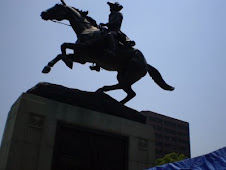Statue of Garfield, Wilmington, DE
I've driven past this statue many times, but never knew who it represented. Since I've been taking pictures of stuff around Wilmington, particularly monuments, I parked the car and took a look. The statue is labeled "Garfield," and I assume it is James Garfield, president of the United States, and not Garfield the cat.
Why Garfield? Why Wilmington? I don't know.













7 comments:
Why the fence? Are they afraid someone will steal the statue?
I wondered about the fence too. It's not the greatest neighborhood in the city.
Maybe someone is buried there?
The 2000 book "Wilmington in Vintage Postcards" by Marjorie McNinch has, on page 123, a Hagley-sourced image showing the statue in Wilmington at Eleventh and Washington, until P. S. du Pont widened Pennsylvania Avenue in 1916, when it was moved to its current location. (Source. As to why it was situated in either place, I do not know.
I'm from the first generation of asshole on that block and im not proud but I no why it was put there...because of how the triangle it sits on is shaped.Concord ave. an 23st comes to an angle at monroe st which is called a"right side triangle".he came up with the proof that four of those triangles made a square...
I'm from the first generation of asshole on that block and im not proud but I no why it was put there...because of how the triangle it sits on is shaped.Concord ave. an 23st comes to an angle at monroe st which is called a"right side triangle".he came up with the proof that four of those triangles made a square...
I agree with the above comment about the right angle triangle at 23rd and Monroe. The Garfield theorem that the square of two sides of the triangle added together result in the square of the 3rd side of the triangle is sometimes known as the "Pythagorean Theorem" named for a math student of Greek descent who was Garfield's lab assistant at Wilmington High before running successfully for political office in Sussex County. In earlier times the math teachers at P.S. would take their class on a field trip to the Garfield statue; everyone would march in single file around the triangular block and count the number of footsteps it took to walk around 4 (maybe it was 3) of the triangles on that corner and calculate the area of the square which they added up to. Then they would feast on fresh donuts from Hearns Market and return to school. I don't know why, though, Garfield got the credit rather than the poor student, Pythagorus, who really deserved the credit for that discovery. Also, I'm not sure if it was 3 or 4 triangles which make up the square or why the class celebrated their math outing by feasting on a round donut from Hearns; that's still a mystery.
Post a Comment